Istria and Dalmatia Were Favourite Regions for Car Tourists This Summer
October 11, 2020 - The German Auto Club (ADAC) declared Istria and Dalmatia the favourite regions for tourists who traveled by car this summer amid the corona crisis. And not only that, but Croatia is also at the top of the most sought-after countries for holidays together with Germany.
As Jutarnji.hr reports, this data was based on the analysis of 345,547 inquiries for routes, which, due to the specifics of this year, is much less than in previous years, and refers to the period between May and September.
The analysis showed that the largest number of German travelers this year still decided to stay in their own country, which is also the case in normal seasons when a large number of Germans stay in Germany. This year, this is even more pronounced due to all the restrictions around border crossings and travel opportunities in general. As many as 33.3 percent of inquiries for routes referred to Germany, which is more than last year.
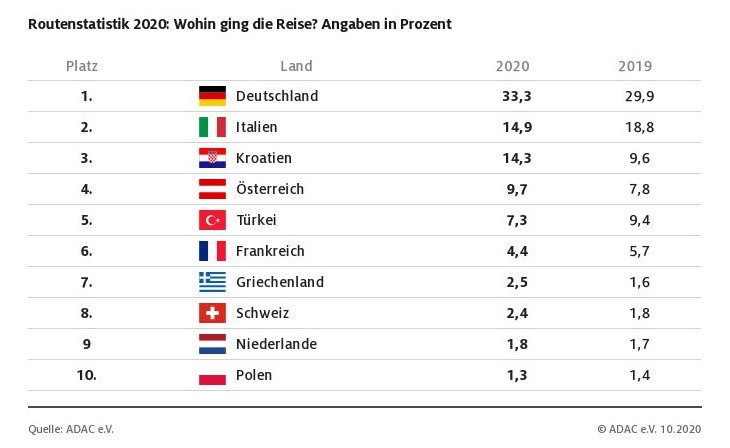
Route statistics 2020: where did the journey go? Numbers in percent / Source: ADAC
Italy took second place with 14.9 percent of inquiries and a big drop compared to last year when it had 18.8 percent of all inquiries.
Croatia is in third place with 14.3 percent of inquiries, which is an increase compared to last year when it had 9.6 percent of inquiries, reports ADAC. Interestingly, Spain was not among the top 10 most sought after countries, and last year it was in seventh place.
The most favorite regions of German guests who decided to travel by car were Istria and the Dalmatian coast, and inquiries for holidays on the Italian Lake Garda, which Germans adore, fell sharply. That is why three German provinces benefited – Southern Upper Bavaria/Allgäu, Schleswig-Holstein, and Ostsee/Mecklenburg-Vorpommern.
Top ten regions in percent / Source: ADAC
What ADAC particularly noticed was the fact that camping tourism boomed. Most campers opted for Germany, 35.1 percent of them. Croatia has overtaken Italy in this segment and holds the second place with a 15.4 percent share.
For the latest travel info, bookmark our main travel info article, which is updated daily.
Read the Croatian Travel Update in your language - now available in 24 languages.
Over 1,000 Caterers in Dalmatia Closed Businesses for 60 Minutes on Thursday
September 25, 2020 - More than a thousand caterers in Dalmatia stopped serving guests in their facilities for an hour to warn of the difficult situation their businesses are in. The protest began at 11:56 on Thursday afternoon.
HRTurizam reports that as part of the action "4 to 12", Thursday's protest was initiated by the National Association of Caterers and the Split Association of Caterers, though word quickly spread to Zadar, Sibenik, Dubrovnik, and other Dalmatian cities and towns and was a complete success, the organizers said.
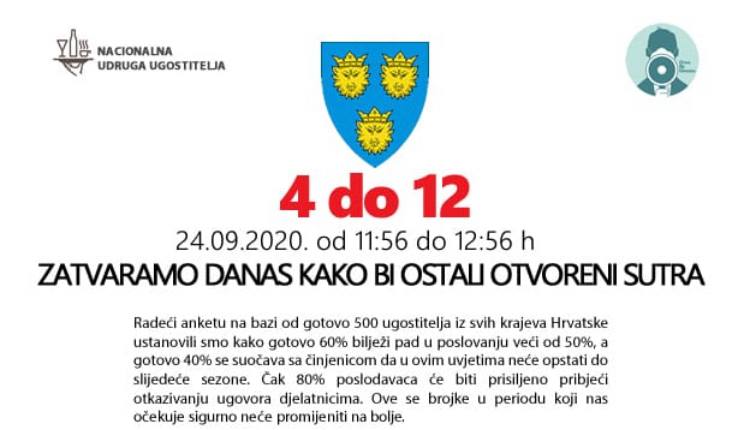
Caterers decided to take action because the coronavirus pandemic endangered the food & beverage industry's survival and the numerous jobs on which tens of thousands of employees and members of their families depend on in Dalmatia alone.
"I am pleased that the caterers responded in such large numbers, but even more pleased that our guests recognized the importance of the action and accepted our reasons as to why we stopped serving them for 60 minutes with understanding. Our demands for measures needed to preserve jobs and prevent the collapse of the economy are clear - suspension of VAT until March 1, 2021, a permanent preferential rate on food - which according to the Food Act, includes food, coffee, beer, juices, water, and wine - of 13% or 10%, access to credit lines of HAMAG BICRO for liquidity and HBOR for investments," said Jelena Tabak from the Split Association of Caterers.
The action is designed as a continuation of the recent action of caterers of Istria and Kvarner with the same goals, only this time it was not called "5 to 12" but "4 to 12" to warn of the fact that time for action of competent institutions is running out and will soon be too late.
Hundreds of restaurants, cafes, and shops closed in Split alone to show their support, and more than two hundred in Zadar and its surroundings. In Zadar and Hvar, only the facilities of local leaders of the Croatian Chamber of Trades and Crafts have been opened.
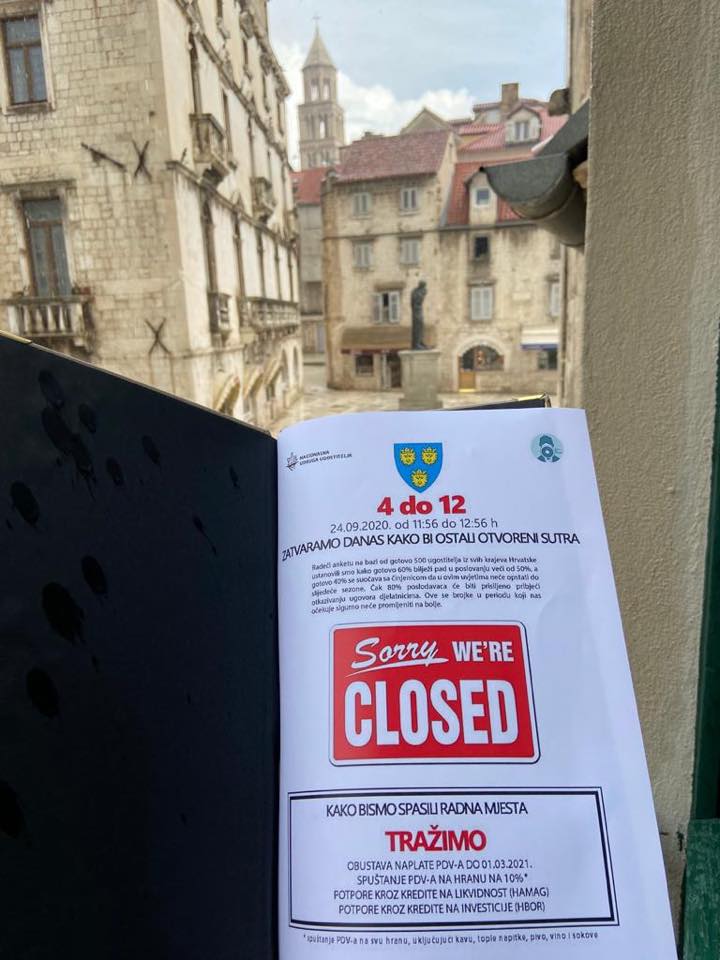
Udruženje ugostitelja Split
Caterers emphasized that the season was better than in other Mediterranean countries, but not enough to bridge the gap created by a lockdown in the spring, falling tourist numbers, and the abrupt end of the season due to the closure of other borders.
"We do not ask for any alms, nor do we want other people's money. We are only asking to be allowed to borrow to survive until next season and be relieved of the tax burden to some extent so that we can pay the loan. Several other measures could help us at the local government level, from relieving consumption taxes to reducing concession fees. Still, key measures that will help all caterers - VAT and availability of liquidity and investment funds - must be addressed at the state level," said Jelena Tabak.
A sample survey of almost 500 caterers from all over Croatia found that almost 60% of them recorded a decline in business by more than 50%, and almost 40% face the fact that under these conditions, they will not survive until next season. As many as 80% of employers will be forced to resort to terminating contracts with employees.
For the latest travel info, bookmark our main travel info article, which is updated daily.
Read the Croatian Travel Update in your language - now available in 24 languages
VIDEOS: Amazing New Google Project Shows Croatian Culture to the World
September 18, 2020 - Incredible new video series explore Croatian culture, its natural assets, and the country's rich traditions, a collaboration with Google
Steeped in history and tradition, Croatian culture is incredibly diverse. Recognised as being of high value to the country's appeal and its understanding of itself, many items from this rich heritage appear on the protected UNESCO list.
The Croatian National Tourist Board has teamed up with Google Arts & Culture and partners The Museum of Arts and the Museum of the Sinjska alka to produce an incredible series of videos that explore this cultural heritage.
From arts & crafts to music and dance, natural assets and architecture, the new videos show off the rich menu of traditions assets that make Croatia such an incredible country. With so many items included on the protected UNESCO list, there's always something more you can learn about Croatia, no matter how many times you visit.
Lace-making, costumes of folklore, ancient instruments, time-honoured recipes, beloved festivities and distinct, regional styles of music are just some of the facets of Croatian culture explored in the videos. Now, people from all over the world can explore Croatian culture and heritage before they even arrive. The menu of videos and accompanying media is presented in both English and Croatian.
Some of the videos in the series are not new, but they have been selected by the Croatian National Tourist Board for inclusion as they are the best at showcasing their particular aspect of Croatian culture. Alongside the video presentations, there are a wealth of photographs and informative texts. You can view the whole new collaboration with Google Arts & Culture here
For the latest travel info, bookmark our main travel info article, which is updated daily.
Read the Croatian Travel Update in your language - now available in 24 languages
Croatia, Full of Poisoned Cats? The Dark Side of Dalmatia's Streets
September 3, 2020 - “Croatia, Full of Life!” says the national tourist board, but are they aware of all of the poisoned cats? A closer look at the animal issue plaguing Dalmatia's streets.
Street cats have become a symbol of Croatia, and whether you find them fishing on the coast, in bins, or enjoying a bit of ‘fjaka’ on an ancient stone wall, you’ll be hard-pressed to miss one while you're here.
But there is a dark side to our furry friends in Dalmatia, something I could never imagine in a place of so much beauty. Cat poisonings.
Growing up in California, my family always had cats. Because we lived on acres of citrus and avocado trees, we'd often wake up to litters in our shed or on top of our cars before I was driven to school. While we found homes for some, we raised others and ensured they were part of our family. Some we had for over 15 years, and all had passed before we moved to Croatia.
Without the responsibility of house pets for the first time in years, the thought of adopting an animal here hardly crossed my mind. And to be honest, I went four years in Split without taking any in. That is, until a kitten drove under our car for 20 minutes before falling out in the middle of the highway, which I heard only thanks to a hunch in my gut that something wasn't right. Suzy drove home with us that day and became my first kitten love in Croatia. Just over two months later, a 3-week old kitten was abandoned by its mother on a rainy Sunday night near my home, and while I tried finding him a forever home, Ziggy became a Rogulj, too. And that’s only the beginning.
However, it wasn’t until I rescued Ziggy that I became wholly exposed to the depths of the cat community in Split and Dalmatia. While I had friends actively involved on the streets or Facebook, I was often hesitant to join for fear of uncovering its somber side. Part of me enjoyed being blissfully unaware, thinking that the street cats here are healthy, happy, and have homes, as many people want you to believe. Unfortunately, it’s far worse than I’d ever imagined - and for anyone with the slightest bit of compassion, impossible to turn your head.
Not only do cities seldom help in sponsoring sterilizations for street cats (there are a few exceptions, like Stari Grad, which I will go into later), but many citizens believe that cats are pests, and pests must go before the tourists arrive. This is where the act of poisoning comes in.
At the beginning of August, Jutarnji List reported on 17 cats that were either poisoned, beaten, or drowned on the island of Hvar in a matter of weeks, terrifying tourists who left their accommodation because they found a dead cat in the courtyard. They added that dog owners were scared to leave their homes, and parents were hesitant to take their children to playgrounds for fear of them coming across traces of poison. The poison used, they said, was potent, and nothing anyone, let alone a cat, should come into contact with.
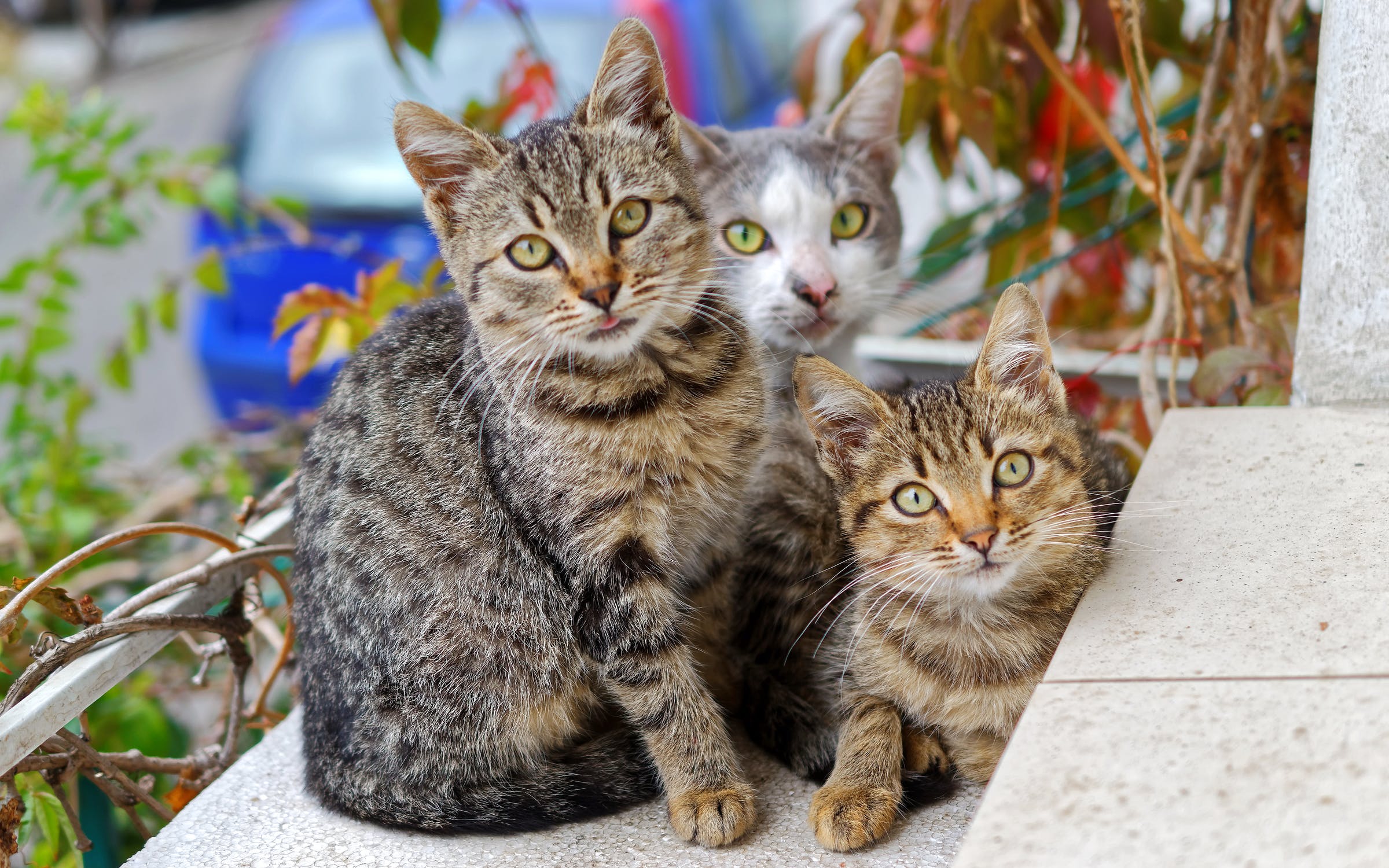
Pexels
Hvar, however, is only one example. Kelly Parslow, an ex-pat who has lived in the village of Osibova on Brac for years, has lost eight cats to poisonings.
“I believed foolishly that the first time it was an accidental poisoning. I was aware that cats were often poisoned here, and a colony of street cats that I cared for was wiped out by poison a few years before. But I couldn’t believe that my neighbours would deliberately harm MY cats. I was very wrong,” said Parslow.
Kelly first realized two of her cats went missing while she was caring for another she found foaming at the mouth.
“Both of these cats came to me as unwanted kittens, left at my house during the night by people with unsterilized house cats, who were allowed to roam freely, and ended up pregnant. Before I moved here, the unwanted kittens would be left at the neighbourhood rubbish bins, and kind-hearted locals would feed them until they were inevitably poisoned, to “clean” ahead of the tourist season. Then word spread of the crazy foreigner who loves cats, and soon, the kittens were turning up at my home. I didn’t mind, though. I have enough space at home and in my heart for these poor creatures. I believed they would be safe with me. My home is surrounded by forest and sea. Osibova is a neighbourhood of vikendice and apartmani. I am one of only a few year-round residents. The neighbours who come in summer love my cats. Children often come to feed and play with them. A retired couple even adopted one particularly friendly cat. They were not previously “cat people,” but my sweet girl converted them, and they adore her completely!”
And the poisonings didn’t stop there.
“With the third victim, I realised that this was no accidental poisoning. My cats were deliberately killed. People told me it was probably hunters who leave poison in the forest for reasons I don’t entirely understand. Reports of more poisoned creatures started pouring in. Two puppies, many kune, and even owls. Who knows how many other creatures were carelessly slaughtered. That’s the thing with such a poison. It doesn’t only kill the targeted animal. It passes through the entire food chain, killing big and small creatures and contaminating the environment. It never disappears, it slowly dissipates but not before causing untold damage to the delicate ecosystem,” Kelly said.
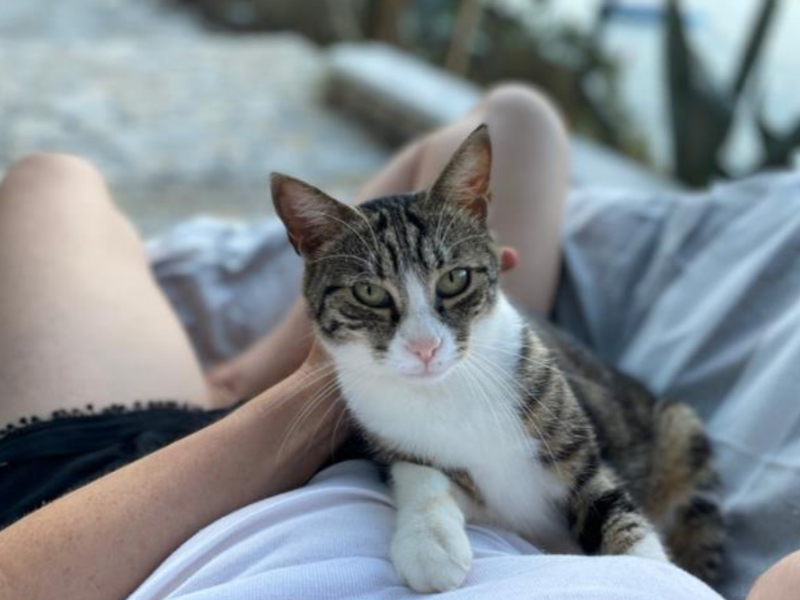
A week later, she found the fourth victim, Tootsi.
“He was a refugee from Milna, his clipped ear a sign that he had been one of many cats sterilized in a large ‘Trap Neuter Return’ effort, carried out by volunteers and paid for by the Municipality. He had only one eye, the other most likely shot with an air rifle, in some twisted version of target practice for hunters. Despite all this, he was sweet, friendly, and grateful for my care and affection. I found him under a bush, foaming at the mouth, crying in pain and fear. Again I rushed to the vet, but he was dead by the time I arrived.”
Kelly resolved to building a cat-proof fence on her property to protect her remaining cats, though work cannot begin until after the tourist season as building work is prohibited.
“At the same time, 2 cats disappeared. I never found their bodies. The death toll stood at 5. I thought that the opening of the tourist season would protect the remaining cats. Surely no one would drop poison around when so many people with young children and dogs were here enjoying their summer holiday! I underestimated the stupidity and savagery of the culprits.
Last week, I heard that more cats had been poisoned in Osibova. Orphaned kittens were found, some dead, some clinging to life. Three of my cats were missing.
I searched the neighbourhood for days until I found the body of my beloved Turtle. She crawled under the wooden kučica for cats that I built in my garden. There she died the same painful, terrifying death as the others.”

Shocked by Kelly's experience, I decided to take a poll of my Facebook friends to see who else has witnessed something similar. The situation in Slatine on Ciovo is no better.
"I would like to draw your attention to Slatine (Ciovo), where such a practice is repeated from year to year, on a much larger scale (although almost unknown to the general public). This year alone, already three times, dozens of cats have been poisoned. Non-selective poisoning, in public places, without warning and notice (and permission), which endangers both children and other pets. The motive is simple, out of season, cats are desirable because they 'control pests and snakes' everyone feeds them and lets them reproduce uncontrollably, and in season, they are 'enemy number 1 because tourists come,' and Slatine residents have no urge to keep the place clean, so cats gather in crowded containers in groups of up to 30," reads one message I received on Facebook. The source added that Slatine is officially part of the City of Split, and the Split district, which makes the story even crazier.
Unfortunately, it is known in the community that the police rarely act on reports of cat poisonings.
“Cat poisonings are amongst the major issues when it comes to animal welfare in Dalmatia. These atrocities happen regularly throughout the year, the work of psychopaths who go unpunished, with a big spike during the spring and summer months. The reason is that many accommodation and restaurant owners are convinced they need to 'clean the place of cats' so they don't bother tourists. This makes no sense whatsoever, given that the visitors love cats and seem to show a lot more empathy for them than most locals. Our association has reported dozens of cases to the police, but it is never taken seriously, and often, we are even laughed off. The authorities don't seem to think cats' lives are worth their time and resources,” said Tanja Vukicevic of the Split association Deseti Zivot.
Zdravko Podolski, a resident of Vrboska on the island of Hvar, has lost three cats to poisonings, oftentimes with no luck from the police - but that shouldn't discourage people from reporting.
"Always report, to grad/opcina, to police, to komunalno redarstvo, to drustvo za zastitu zivotinja. From the police, insist on a case number. If you have suspicions, share them. Nothing will happen the first few (or even many) times, but you can ask for a report, and you can set the press to ask," he says. Printing out articles in the media about poisonings and placing them in the mailboxes of suspects could work, too.
Parslow believes that if several people report the same crime, the police can do their job.
“People say the same thing to me over and over: don’t bother to report it because the police don’t care. This is not true at all. In my experience, the police care a lot and are always sympathetic. They can’t do anything if they don’t know the crimes are happening. By not reporting, people ensure that nothing will continue to happen. I always report to the police and the local municipality, but one report is not enough! If several people report the same crime, then there is more information for the police to work with. That is what happened in this case. The police told me that several other people had reported the same incidents of poisoning. Putting all the reports together gives the police a better picture of what is happening. Every piece of information, however tiny, is a piece of the jigsaw puzzle that can lead to prosecution.
There are several different routes to prosecution. An autopsy and toxicology analysis can be performed by the police crime laboratory, but it is very expensive, and citizens are usually expected to pay for it themselves. The poison itself is prohibited in Croatia and must be brought in from neighbouring countries with more relaxed laws. Anyone found in possession of the substance can be prosecuted. Offenders can be caught on video surveillance cameras, and some are even stupid enough to brag about their crimes, effectively confessing their guilt. I urge all concerned citizens to report these crimes. It takes a tiny amount of effort, and you might not see results immediately, but it is worth it.”
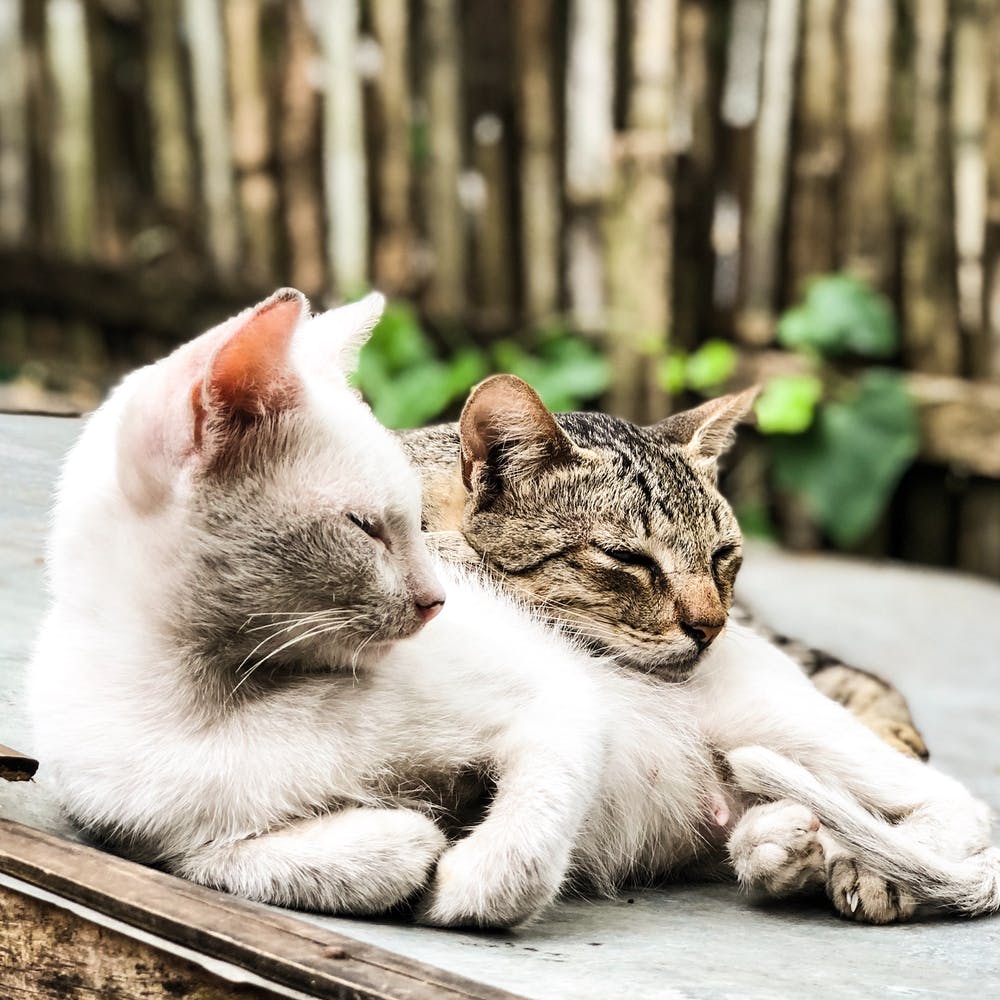
Pexels
I was shocked to discover just how many locals are unaware of what to do if they come across poisoned cats. One message last week from a local university student in the Visoka neighborhood of Split is an example.
"Someone in my street is poisoning cats, and I don't know what to do. I'm so sad about it because three already died."
According to Animal Friends in Croatia, if you are to witness an imminent threat to the health and life of an animal and severe abuse of an animal (including all forms of physical abuse), you are to call 192 and request the intervention of the police to prevent further endangerment of the animal and, if it is torture and/or killing the animal, file a criminal report.
A criminal report for abuse and/or killing of an animal should also be submitted by a witness of abuse/killing of an animal or a person who has information about it, in writing to the competent Municipal State Attorney's Office for violation of Article 205 of the Criminal Code. You can read more about it HERE.
Last week, a 61-year-old woman on the island of Hvar was caught by police for poisoning four cats. Some justice, finally, has been served.
“The people of Hvar are finally relieved: after a police investigation, the case of poisoning and killing cats, which had been buzzing in the news for days, was resolved. Allegedly, some tourists decided to leave Hvar after they came across the corpse of a cat in the yard of the apartment where they were staying, which horrified them so much that they packed up and left.
Although several killed cats were found in the town of Hvar in July, in yards and even in a net at sea, Hvar Police Station officers found that a 61-year-old woman from Hvar had killed four cats, which led to a report of the crime of killing or torturing animals. The competent state attorney's office was informed about the completion of the criminal investigation in a special report, as a supplement to the previously submitted criminal reports,” reads Slobodna Dalmacija’s release on the police report.
Killing or torturing animals in Croatia can see you imprisoned for up to a year.
Vivian Grisogono of Eco Hvar, an association helping to improve the health, environment, and conditions for animals on Hvar Island and beyond, suggests a way forward.
“One has to recognise why there's a problem and the valid reasons why some people object to having cats around their property. And then one can work out solutions, at least to some degree. Firstly, we feel that feeding stations with soil or sand areas for toileting would be a good start. Zagreb apparently has 40 of these. Such feeding points would make it easier to organise the sterilization of strays. Secondly, a satellite shelter (stacionar) would be excellent. One of our members has offered the use of some private land for this purpose, so we are now planning to create a satellite shelter under the aegis of the Animalis Centrum/Zaklada za zaštitu životinja Beštie) shelter in Kaštel Sućurac. It's quite a big undertaking, but is desperately needed.
Getting local authority support for these initiatives, including financial, would be the best possible positive result out of the tragic events of the last few months. Stari Grad, Hvar, and Jelsa have already taken positive action in financing cat sterilizations from their budgets, which was a big step forward, and is due to the initiative of Amanda Blanch and Chris Edwardes, who run the Hidden House Hotel in Stari Grad.
Restaurants and hotels would do well to join in the initiative - it would be good for their image, would help keep local cats under control, and would definitely please the many guests who come here and enjoy having cats around. Also, the cats are, of course, useful in controlling snakes and vermin.”
Amanda Blanch of the Stari Grad Kitten Fund believes we need to use the recent media attention to our advantage to keep the momentum around the issue going.
"There is momentum after the awful killings and torturing of cats in Hvar Town, and finally someone has been arrested. I have never gotten anywhere with the police or authorities on this, but they did finally listen about the Stari Grad Kitten Fund, and after three or more hard years, the mayor did put some money into the sterilization program. It is starting to get traction, and we must keep fighting for change and show people the benefits for them. Tourists prefer not to find dead or dying cats around, and there aren't as many cat feces around our area as the sterilization program worked, as we had fewer cats, mice, and snakes."
While Parslow has grieved eight lives this year, she fears that death could extend beyond cats, and tourism doomed on the island forever.
“The poison, in this case, is a powerful neurotoxin, which usually kills in minutes. It is extremely dangerous to all life, including humans. I fear that if this is allowed to continue, one day, a small child will be killed. Toddlers explore their world by putting things in their mouths. Imagine if the child of a tourist is poisoned in beautiful Osibova. Tourism would be destroyed here forever.
People say it’s the older generation who poison cats. They don’t know and can’t afford any other way of controlling the cat population. This is not always the case and certainly not the case here. The culprits are not old, they are not even from Milna. They are property owners who make a lot of money from tourism. They will destroy anything which gets in the way of their profit. They don’t understand that tourists from other countries do care about animal welfare and would be horrified to learn that cats are tortured and killed for their benefit. They don’t care about the very thing which draws those tourists: the incredible natural beauty of this region.”
If you'd like to get involved by helping the animal associations of Croatia, follow TCN's dedicated page.
For the latest travel info, bookmark our main travel info article, which is updated daily.
Read the Croatian Travel Update in your language - now available in 24 languages
No Lockdown For Split-Dalmatia County
ZAGREB, Aug 26, 2020 - Head of the national COVID-19 management team and Interior Minister Davor Bozinovic said on Wednesday that the new measures for Split-Dalmatia County, announced by the county's team, would come into force at midnight.
"Split-Dalmatia County has decided to make wearing masks mandatory in bars and restaurants before consuming drinks and food, the number of people at weddings will be limited to 50, wakes are banned, and owners of restaurants are obliged to supervise their facilities more closely. Also, gyms will close, and sports competitions can take place but without spectators," Bozinovic said.
Broken down by counties, the number of new cases of the infection is the highest in Split-Dalmatia County - 136, followed by the City of Zagreb (58), Sibenik-Knin County (33), Primorje-Gorski Kotar County (20), Zagreb County (19), Zadar County (15), Varazdin County (11), Brod-Posavina County (11), while other counties have recorded fewer than 10 new cases.
Asked whether the national COVID-19 response team was considering a complete closure of Split-Dalmatia County, Bozinovic said that was not the case.
"We are not considering that this is the only way to avoid that, and I am convinced there will not be any lockdown. We are keeping the situation under control this way," he said.
Asked about the possibility of the spike in number due to the recent Feast of the Assumption, Bozinovic said that they had assigned local teams to conduct epidemiological surveillance, and they believe the prescribed measures had been implemented.
"Split-Dalmatia County is a hotspot and new measures are being taken there. We will have meetings with others on Thursday, so it is possible that some new measures may be introduced then in some counties," Bozinovic said.
Asked why gyms were closing in Split-Dalmatia County while bars remained open and Masses were allowed, Bozinovic said that the new measures would be in place for 14 days.
He underscored that measures could be dropped or extended. Fines for violating the measures are also possible, he added.
"There is always the possibility of penalizing. We hope there will be no need for that because our intention is that as many people as possible accept the recommendations by the Croatian Public Health Institute. The point is for people to follow the recommendations because then we will achieve the main goal, to reduce the number of new infections and control the situation," he said.
For the latest travel info, bookmark our main travel info article, which is updated daily.
Read the Croatian Travel Update in your language - now available in 24 languages
Analysis by Counties: Dalmatia Eight Times Worse than Istria, Will Regional Measures be Discussed?
August 21, 2020 - Why does Dalmatia have such poor numbers, much worse than Istria, Primorje, and other tourist regions? A closer look at COVID-19 in Croatia.
Jutarnji List writes that Germany, the country from which the largest number of tourists come to Croatia, decided on Thursday to put two Croatian counties on the red list - Split-Dalmatia and Šibenik-Knin.
These are counties that have an increasing number of infected people from week to week and are the main reason why the whole country has been placed on the red list of other countries that are important to Croatia, such as Italy and Slovenia.
But why does Dalmatia have such bad numbers, many times worse than Istria and Primorje, and also tourist regions in which, in proportion to the number of inhabitants, there are more tourists this year than in the south? The numbers are laid out quite clearly in the Official Croatian COVID-19 weekly report, and illustrated by the table below:
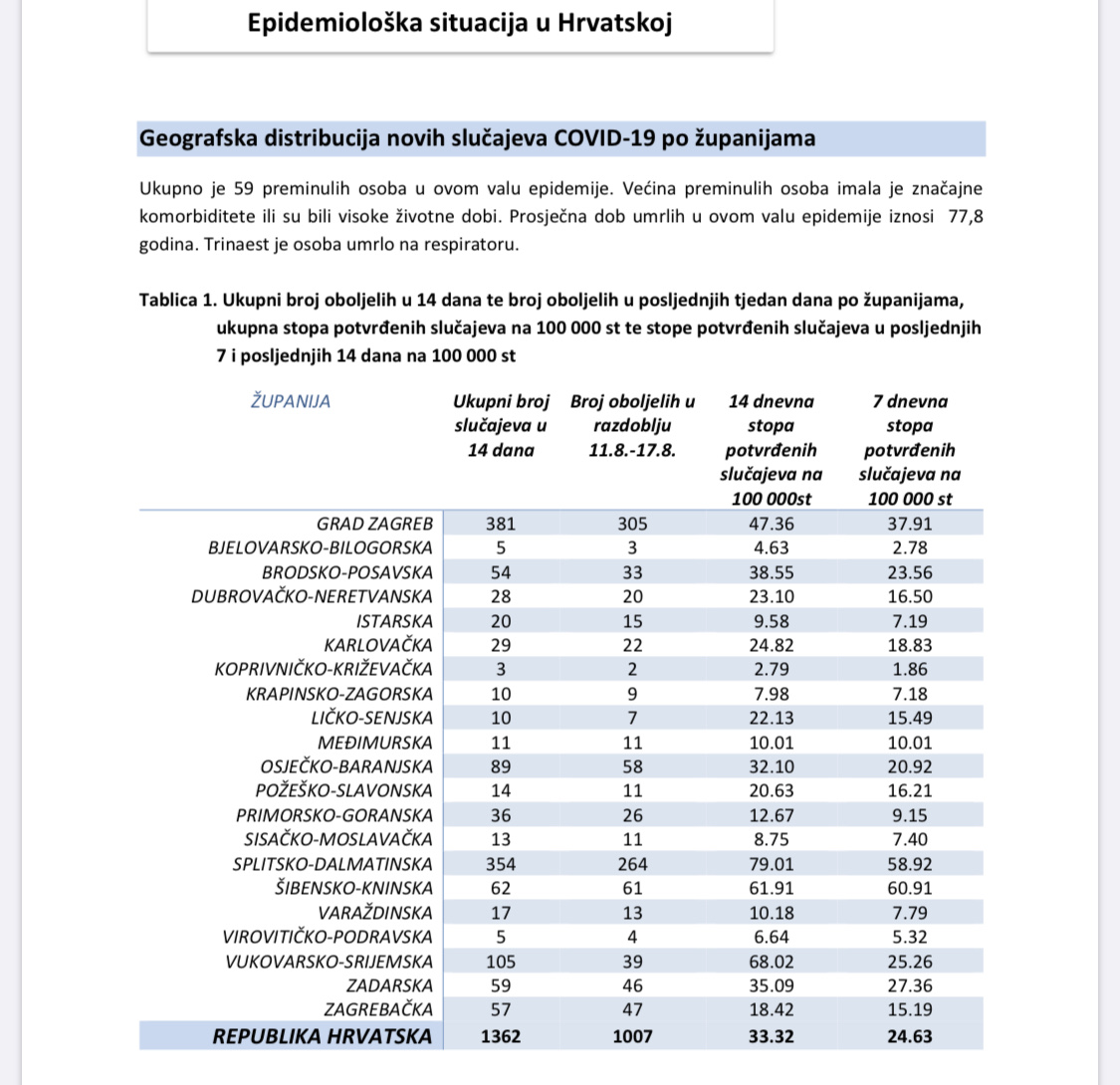
In short, experts believe it is a combination of recklessly relaxed and casual behavior of Dalmatians and relatively mild measures and recommendations of the National Headquarters, which has always tried to balance so as not to jeopardize the season.
They wanted to save the tourist season as much as possible, all doors were open, the result was more than 50 percent of revenue last year, which is ultimately extremely good for the state budget, and covers the costs that await us until the end of the year. However, also the fact that in the last 14 days, including Thursday, Croatia had a cumulative 47.2 infected per 100,000 inhabitants. This is a high number that puts Croatia in an unenviable 7th place among EU countries.
We could have expected that the number would increase by reopening, but the other option was quarantine, which in the end would not be good for either the economy or the citizens. Namely, even this restriction on night clubs is not a sufficient obstacle for the spread of the coronavirus, when a million people from abroad and from the continent come to the Adriatic. The most important thing for them is not the sun and the sea, but socializing, and they will do it either in restaurants or somewhere on the beach.
"Of course, that close contact increases the number of infected people," explains Dr. Krunoslav Capak, director of the Croatian Institute of Public Health. He adds that despite a large number of infected people, most of their contacts are being managed so that newly infected people will arrive from that ‘cluster’ in the coming days, as many have returned to their places of residence.
New possible coronavirus-related measures and strategies will be discussed at the Government's COVID-19 Scientific Council next Tuesday.
Austria, Italy, Slovenia and the UK reacted very quickly to Croatia's large numbers by putting Croatia on the red list, so their citizens are leaving the Adriatic to avoid a 14-day quarantine, and new tourists from those countries will certainly not come this season. Some tourists are being tested for coronavirus in Croatia, so there is currently a real state of siege in public health institutes.
The Zagreb Teaching Institute for Public Health, "Dr. Andrija Štampar", says that in the past few days, they have taken more than 1000 swabs, most of which are Croatian citizens returning to work abroad, but there are also foreigners. The Split institute is also crowded, mainly because hotel houses organize testing for guests. It is estimated that more than 500 citizens are tested daily, of which about fifty are foreigners.
In the last 14 days in Split-Dalmatia County, 79 positives per 100,000 inhabitants were recorded, which is an absolute record since the beginning of the epidemic. That’s the figure until August 17, and it has grown significantly in the past three days.
“Currently, 15 patients with COVID-19 are being treated in our clinic, and two of our patients are on a respirator.
Most of the patients are older than 50 years, but there are also younger ones, but their clinical picture can be said to be moderately severe," says Dr. Ivo Ivic, Head of the Clinic for Infectious Diseases, University Hospital Center Split. He adds that there could be more elderly patients soon, because young people, unfortunately, will surely infect their elderly family members as well.
Split-Dalmatia County is followed by Sibenik-Knin County with 61.91 cases per 100,000 inhabitants, while in Zadar, it was 35.09 cases.
Vukovar-Srijem County, with 68.02 patients per 100,000 inhabitants, is also included in this group of fast-growing corona cases, because according to data, more than half of the positives come from vacations.
At the same time, the three counties of the northern Adriatic are not among those in which tourists and vacations activate the virus. For example, in Istria County in 9 days, there are 9.58 infected per 100,000 inhabitants, or eight times less than in Split-Dalmatia County.
In Primorje-Gorski Kotar, it is 12.67, and in Lika-Senj 22.13 per 100,000 inhabitants, which is a lot for that county, and the reason, according to the numbers, is Zrce. Namely, 159 foreigners who became infected in Croatia were reported to the European EWRS system in just over a month, namely 69 Austrians, 52 Slovenes, 13 Germans, 22 Britons and three Italians. Among the reported infected foreigners, most of them fell ill in Novalja, 71, and Makarska and Split 65.
From these data, it is evident that large gatherings, regardless of whether they are nightclubs, weddings, or birthday parties, are a source of infection for a large number of people. That is why a week ago, the National Civil Protection Headquarters limited the working hours of nightclubs until midnight, and even before the number of those who can stay indoors in those clubs.
However, at that time, there were already too many infections so that this would not drastically affect the overall picture of the coronavirus in Croatia. As expected, many caterers were not pleased. Some even said that these were communist moves, because they were not all the same; some respected the measures already introduced, and they were punished in the same way.
However, after opening nightclubs in the summer, it is evident that the Headquarters will have to weigh the good and bad and learn from this experience to determine what behavior will be allowed during the winter.
For the latest travel info, bookmark our main travel info article, which is updated daily.
Read the Croatian Travel Update in your language - now available in 24 languages
Join the Total Croatia Travel INFO Viber community.
PICTURES: Converted Island Monastery LOPUD-1483 Near Dubrovnik Offers Stunning Luxury
July 31, 2020 - PICTURES: Converted island monastery LOPUD-1483 near Dubrovnik offers incredible luxury
Set inside a former 15th-century monastery, LOPUD-1483 is one of the newest luxury dwellings south Dalmatia has to offer. Located on a car-free island, just seven miles off the coast of Dubrovnik, the stunning property has already caught the eye of the international press.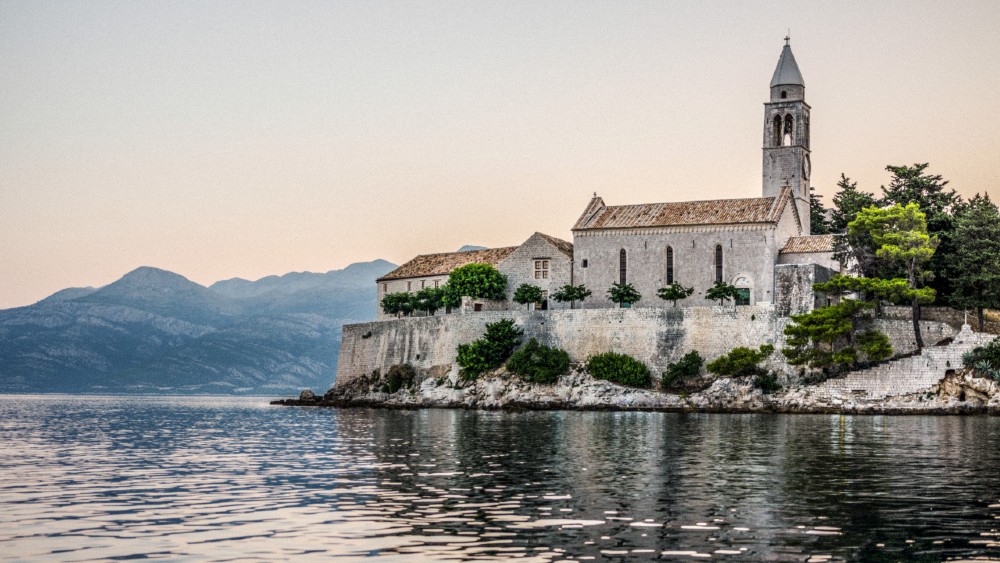
© LOPUD-1483 lies inside a former island monastery and walled fortress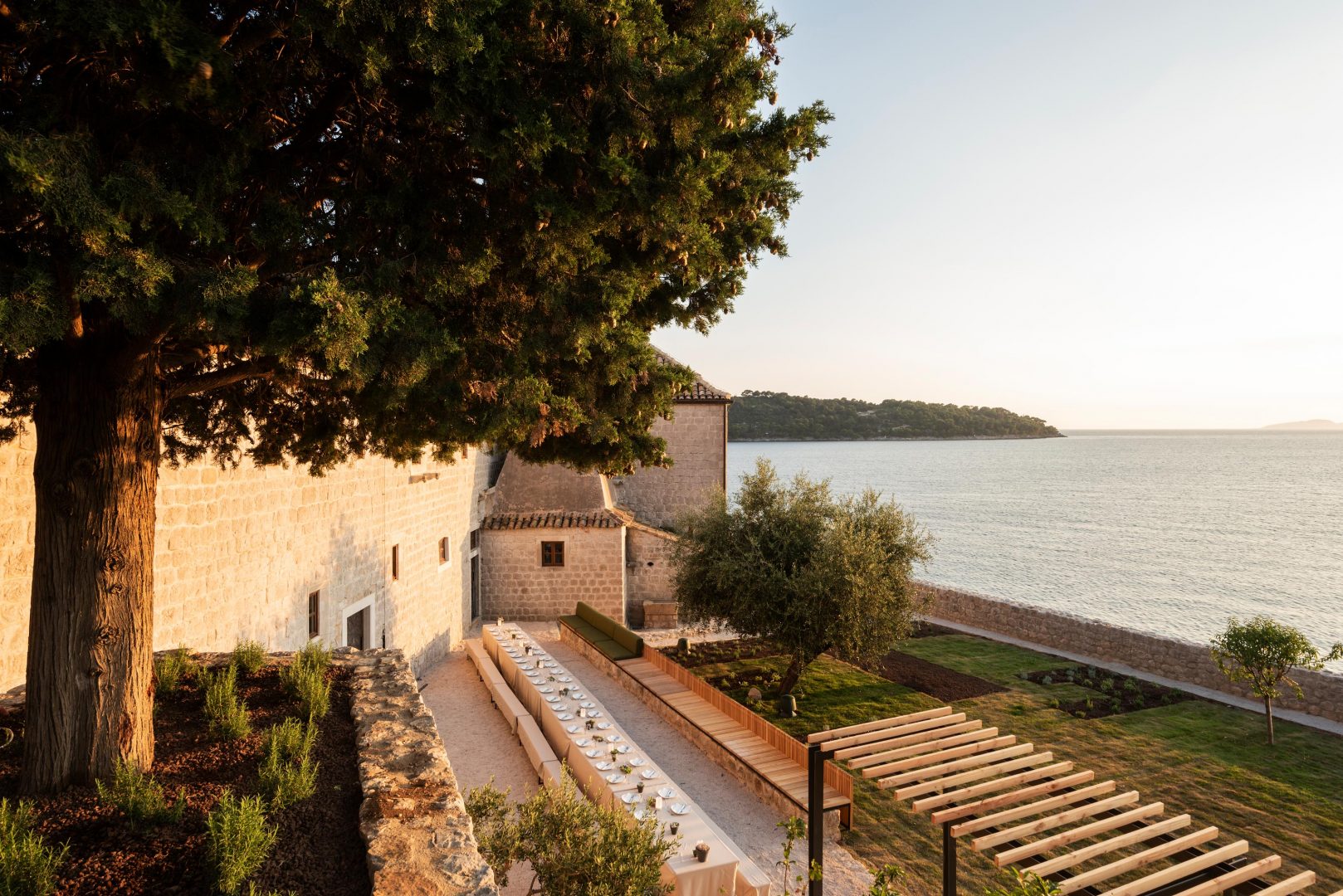 Sunset from the terrace
Sunset from the terrace
Available as an exclusive buy-out for groups during peak season (its five suites are available individually later in the year), LOPUD-1483 also features a slightly younger walled fortress which lies adjacent, surrounding manicured gardens and an unobstructed view of the sea, lying just a few metres away.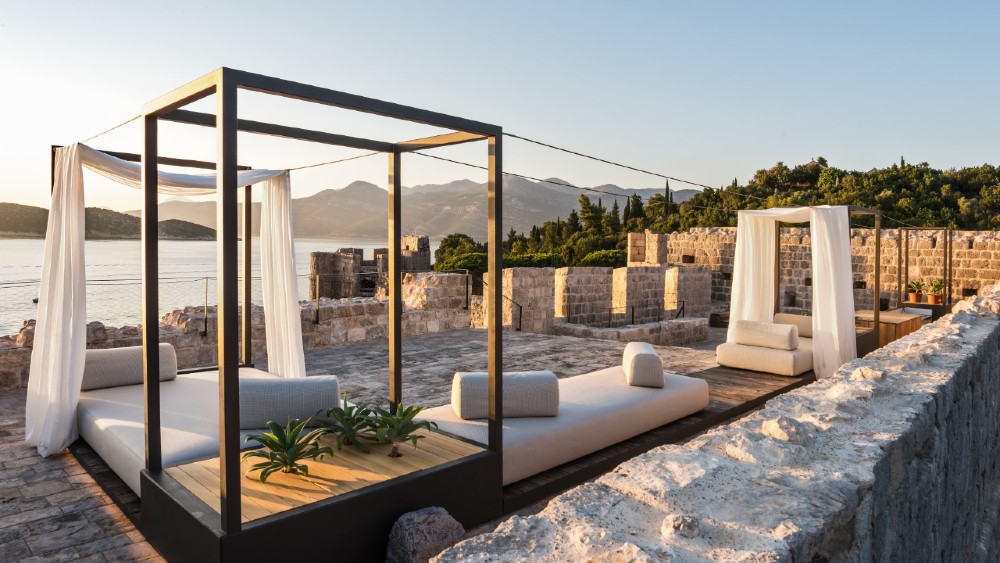
Head to the rooftop for relaxation or yoga sessions
It is aimed towards family or other groups who can rent together, such as those organising yoga retreats, small business conferences, weddings and birthday parties The property balances its historic architecture with contemporary interior design and all the fixtures and fittings you'd expect fro a luxury resort.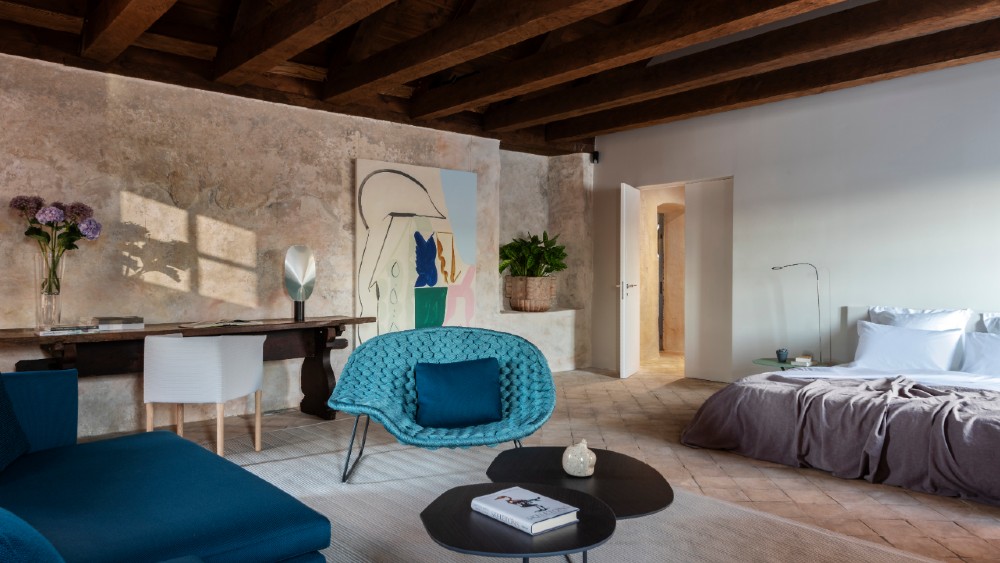
The property balances its historic architecture with contemporary interior design and all the fixtures and fittings you'd expect 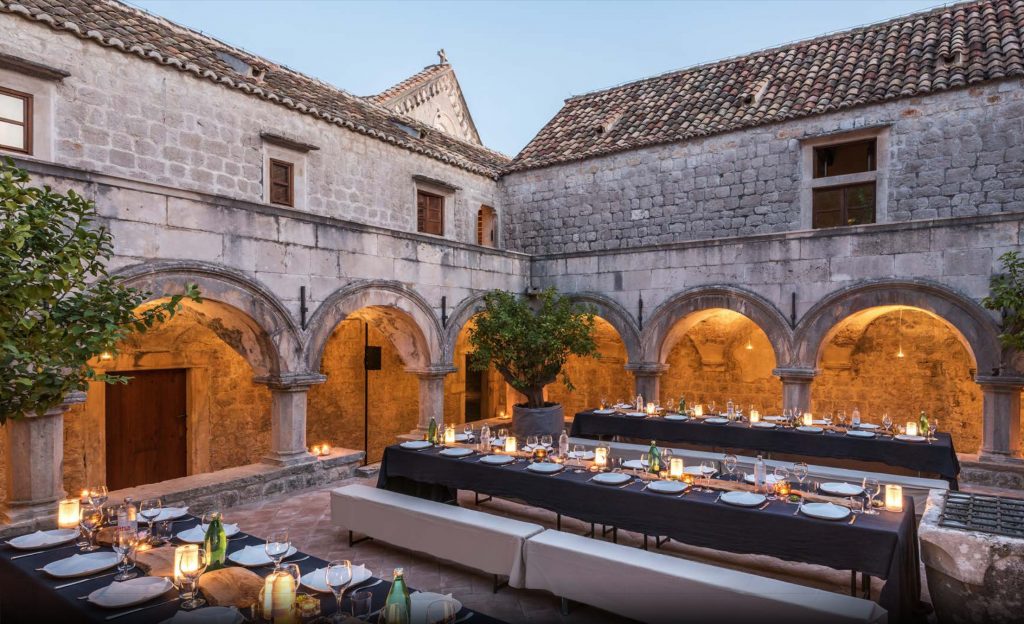
The courtyard dining area is perfect for weddings or functions
LOPUD-1483 also holds ample space to display art and this year has a season-long exhibition from a private collection belonging to the Thyssen-Bornemsza family. The resort has the option of private chefs and a complimentary boat service between the island and Dubrovnik for longer-staying guests.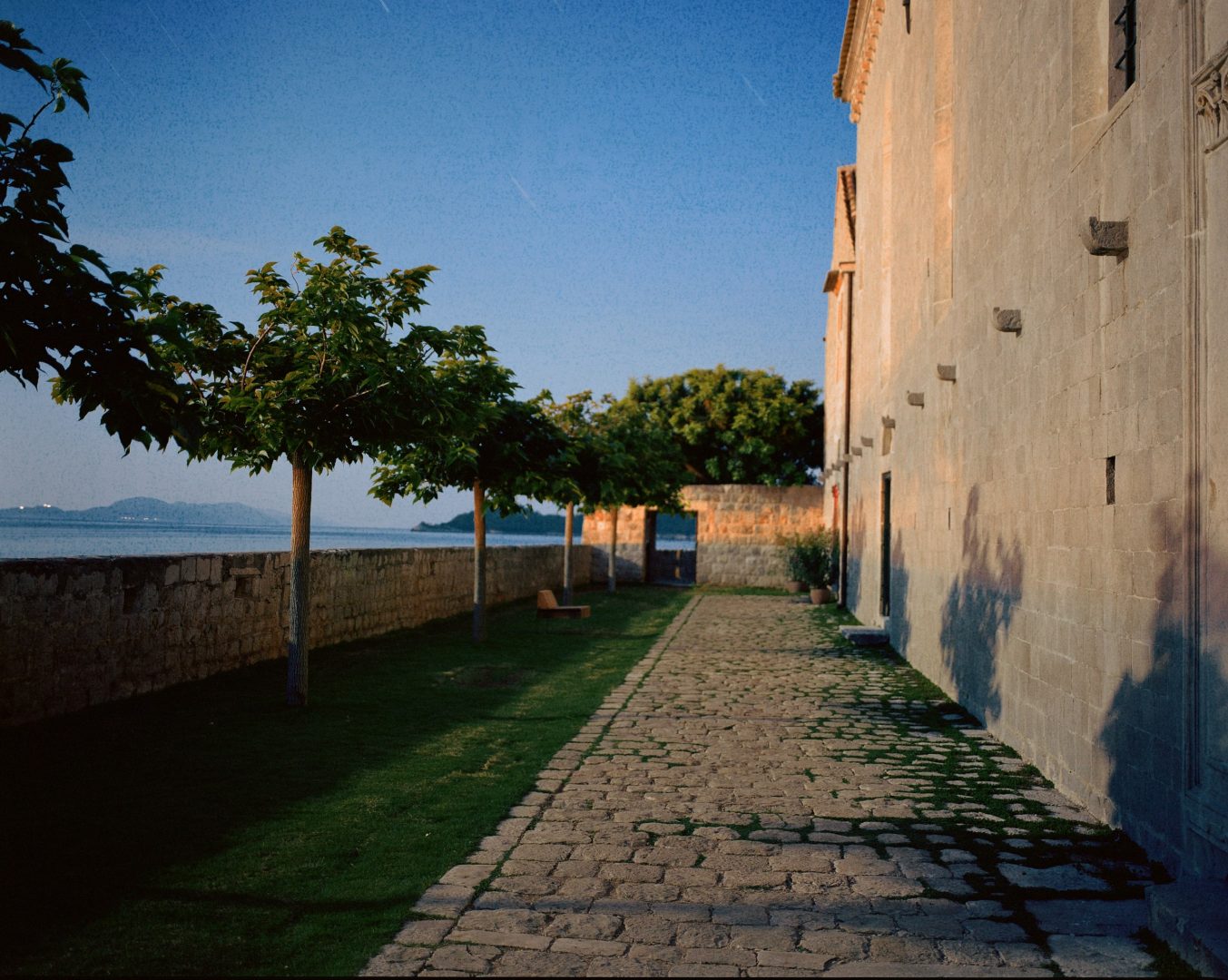
Walls of the historic property are just yards fro the sea
Rates start at €1,400 per night, including breakfast, with a minimum three-night stay. Buy-outs start at €10,000 per night.
All photos © LOPUD-1483
Rešetka's Superior Summer Street Food Brings Fine-Dining Quality at Coastal Pop-ups
July 13, 2020 - In their first venture to the Croatian coast, Rešetka's summer menu brings fine-dining quality to seaside streets in 2020
Sometimes you just want a burger, a sandwich, or something you can just eat from your hands. But, just because you haven't got the time or can't be bothered with the faff of fine dining, that doesn't mean you're volunteering for a drastic drop in quality.
That's where Rešetka comes in. Street food providers renowned for sourcing and selling only quality meats, the grill specialists have been a highlight of Zagreb Burger Fest and several pop-ups in recent times. This summer, the experience that has won over the Croatian capital's burger connoisseurs can be found instead along the coast.
Rešetka owner Nikola Božić has embarked on the summer venture with chef Katarina Vrenc. You'll be able to find their new concept 'Fine Street Food by Reshetka & Katarina Vrenc' at several pop-up locations along the Adriatic this summer. They'll be visiting Istria, Kvarner and Dalmatia, including the islands of Cres and Pag.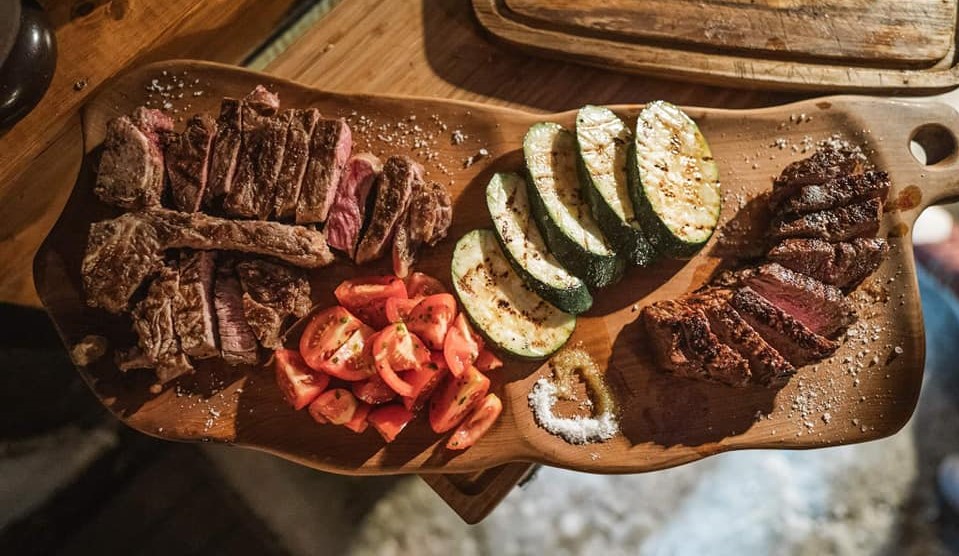
Rešetka and Đurina Hiža are renowned for using only high quality, locally sourced produce within their dishes including, this year, beef from a hybrid of Japan's famed wagyu and Holstein, sourced from the first range herd of its kind in Croatia © Rešetka
With a commitment to cooking only with high quality, locally sourced produce and ingredients, the team is known to use premium meats and seafood for their dishes. This year they will offer beef from a hybrid of Japan's famed wagyu and Holstein, sourced from the first range herd of its kind in Croatia. Within a summer menu that combines the best of continental and coastal Croatian ingredients, you'll also find superior snacks such as rich pork belly paired with octopus.
Nikola Božić is also the proprietor of Đurina Hiža near Varaždinske Toplice. As recently covered in TCN, thanks to some quick and positive thinking, though the restaurant closed for a while in the Coronavirus lockdown, Nikola was able to adapt his business in order to remain successful during the period; relying on high quality, locally sourced ingredients, he became a bridge between the small producers he'd spent time finding, and those shopping online from their homes. Their 'Deda Goes Around the World' service delivered meats and other produce throughout Croatia during the restaurant's temporary closure.
If you're planning to visit Dubrovnik, Biograd, Pula, Premantura or Split this summer and can't face another pizza slice, kebab or burger of questionable origin, be sure to look out for the Rešetka logo. Fine Street Food by Reshetka & Katarina Vrenc will visit Plavica Bar on island Cres on 7 & 8 August and the Michelin-starred Boškinac on Pag in the middle of September. Further inland, they'll also be available at the High Grounds Festival in Varaždinske Toplice on 31 July, 1 & 2 August. Grab yourself a handful of delicious food and pick a spot to watch the stunning Croatian sunset, the Adriatic coast and its breathtaking backdrop has long been lacking exactly this standard of street food to accompany.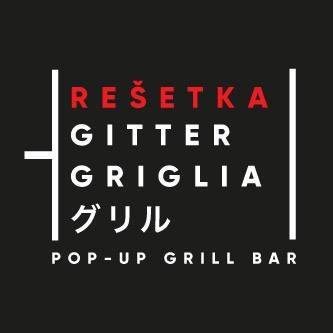
© Rešetka
Bura Wind Leaves Traces: Two Passengers On Destructive Wind This February
June 16, 2020 - Four months after terrifying bura wind blasted through Dalmatia at 270 km/h, TCN received a message from two travellers who experienced the bura in the worst way imaginable.
Alicia and Diana were on RSD Travel's one-week tour of Croatia, Bosnia and Herzegovina, and Montenegro. They travelled from London to Dubrovnik on February 4, 2020. Unfortunately, due to the strong bura winds, the plane was unable to land at Dubrovnik Airport (it was due to arrive at 21:00), and the flight was diverted to Split. Since the accommodation for the first night of the tour was in Dubrovnik, not Split, they were taken by coach to Dubrovnik, arriving at about 3 am. On February 5, they explored Dubrovnik's old town, and then Ston, before travelling to the Romana Hotel in Makarska, where the tour group spent two nights.
When they arrived at the Romana Hotel, the tour bus stopped directly outside the hotel door because the wind was already getting very strong. As soon as they entered the hotel reception, they were informed that minibuses would transport everyone to the restaurant (even though it is only a short walk) because it was too dangerous to walk outside in the strong wind. There were also several signs up in the lifts and reception area informing everyone of these arrangements. Some commented that there must have been accidents in the past for the hotel to be taking these precautions. “It concerned us that the hotel was in the middle of a construction site and all of the building materials looked extremely unsafe and unsteady in the fierce wind, with pallets on the roof teetering on the edge, and cranes swaying in the wind,” said Alicia and Diana.
No-one in the tour group got much sleep that night because of the intense sound of the howling wind, and the feeling of the building swaying from the force of the bura. "Everyone was terrified that the windows were going to shatter on them during the night," said Alicia and Diana, who in the early hours of the morning, also felt an earthquake.
It was difficult to distinguish when the earthquake occurred because the bura was so ferocious and exerted an even stronger force continuously throughout the night. During the night, there was also a very loud bang; it was not until it was light in the morning that everyone realised one of the cranes had blown over.
In the morning (February 6, 2020), the hotel staff were still taking precautions and were busy making sure people didn't go and walk outside to go to the restaurant for breakfast. They created a walkway through the underground car park so that guests weren't needing to go outside. Hotel staff kept people at the door until the wind died down slightly before allowing people to go from the underground car park to the restaurant.
"We went down to reception with plenty of time before the scheduled departure time for the day’s sightseeing (in Split, Trogir, and Omis)", said the passenger, whose guide for their tour group, Hattice, said the bus was ready and ushered people out the door.
"As instructed, we went outside and walked towards the bus that was parked directly outside the door, but then realised it wasn't our group’s bus," said the passengers, whose bus was parked the furthest away from the door. It was past the hotel building, which meant that it wasn't shielded from the strong bura wind, and was on a rocky gravel surface, not on tarmac.
Since several tour groups (all on the RSD trip) had stayed at the same hotel, there were three buses lined up, and due to the poor coordination of timing, all of the groups were departing at a similar time, which meant not all of the buses could be directly there waiting outside the door.
Alicia was walking to the bus; the bura's strength increased in intensity and was still making a fierce howling sound. When Alicia had almost reached the door of the bus, there was suddenly a massive gust of wind. Despite trying to resist the pulling and pushing of the intense wind, and trying to keep her feet grounded, her entire body was lifted into the air. She was blown at a terrifying speed and then forcefully thrown down to the ground, more than 20 metres away from where she had been standing.
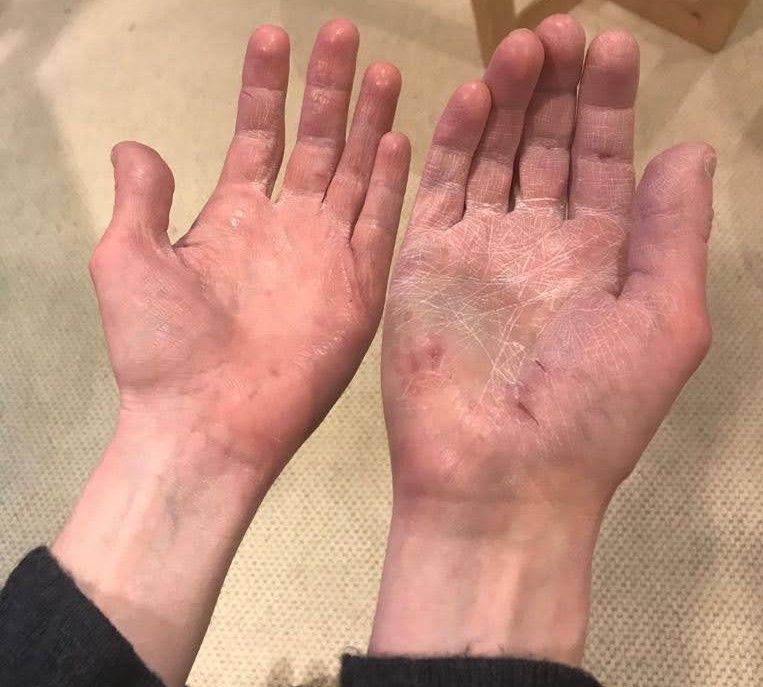
"I was thrown face-first, with my head hitting the ground and rebounding back, while the right-hand side of my body simultaneously bore the brunt of the impact," said Alicia. Her initial instinct was to try to get up, but when she turned over and tried to stand up, she was knocked down once again by another gust of wind, with her head hitting the ground for the second time.
Her whole body hurt; both of her hands were grazed and bleeding, her jeans had been ripped through at the knee, and her knee was also grazed and bleeding. She was unable to move her right hand and arm. One of the men in the tour group ran towards her and picked her up and took her back to the hotel reception, where the tour guide was still directing people to go out to the bus.
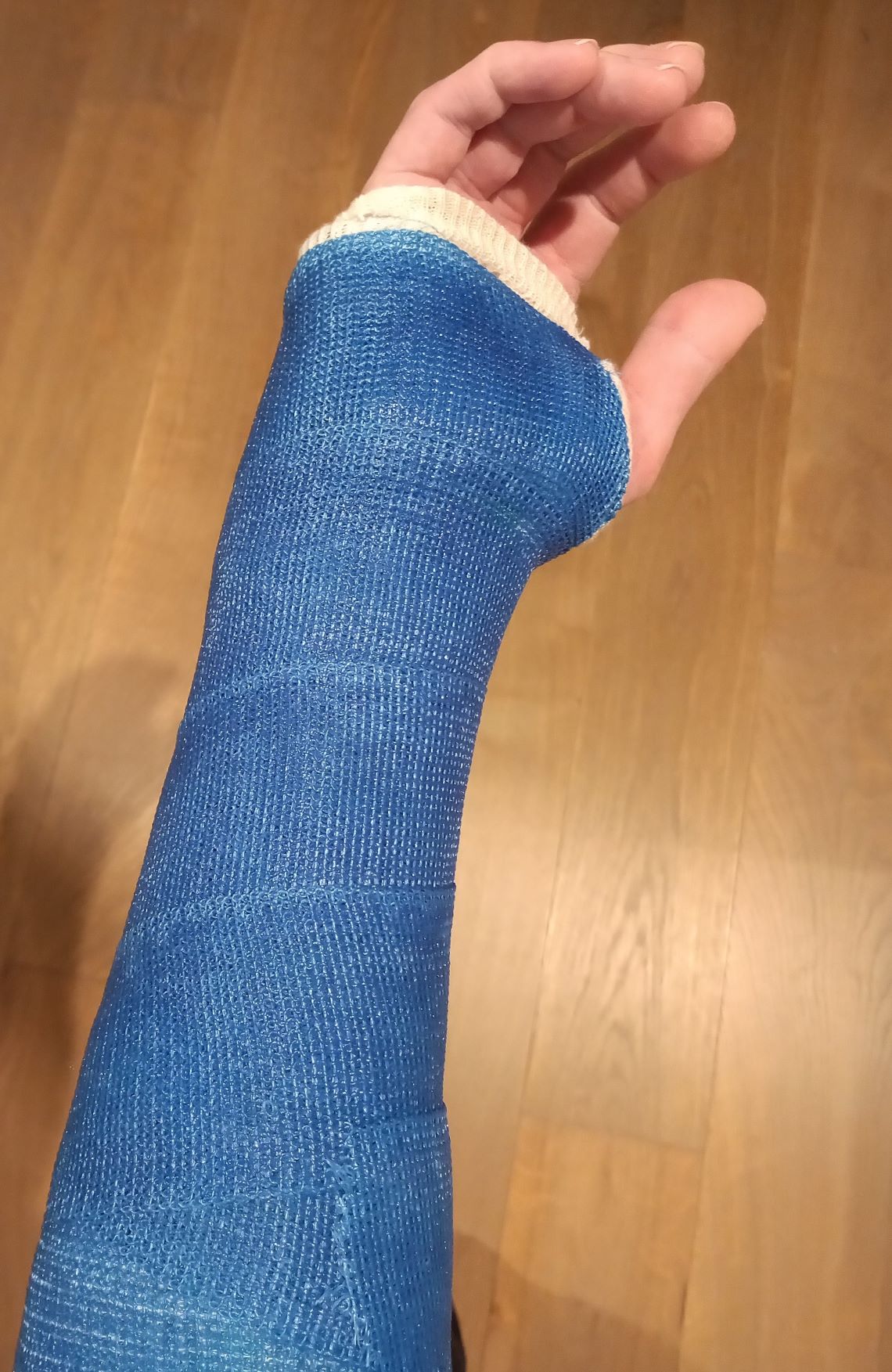
She went to wash the gravel and rocks out of her hands while the reception staff looked for a first aid kit. Unfortunately, they only had limited first aid supplies and were only able to provide her with some adhesive plasters to put on the bleeding wounds on her hands. Alicia informed the tour guide that her head had hit the ground, but the tour guide shrugged it off as though there was nothing wrong. The hotel staff then took her in their arms to the bus. When Alicia got on the bus with the tour guide, they then realised that Diana had also been injured by being blown over.
Diana wasn't aware of the incident in which Alicia had been blown over and severely harmed, as she had gone to the bathroom and went down to reception after that. The tour guide instructed her to walk the length of the three waiting buses, even though at that point, the risks were already known because Alicia had already sustained injuries.
Diana had got as far as the second bus when she was forcefully picked up by the wind and blown into the gravel. "The wind was so strong that I was hurled to the ground, face-first. With the palms of my hands facing upwards, resulting in my knuckles smashing against the rocks and stones on the surface of the ground," said Diana, her sunglasses and scarf having been dragged some distance away by the wind, despite the fact that her scarf had been wrapped securely around her neck.
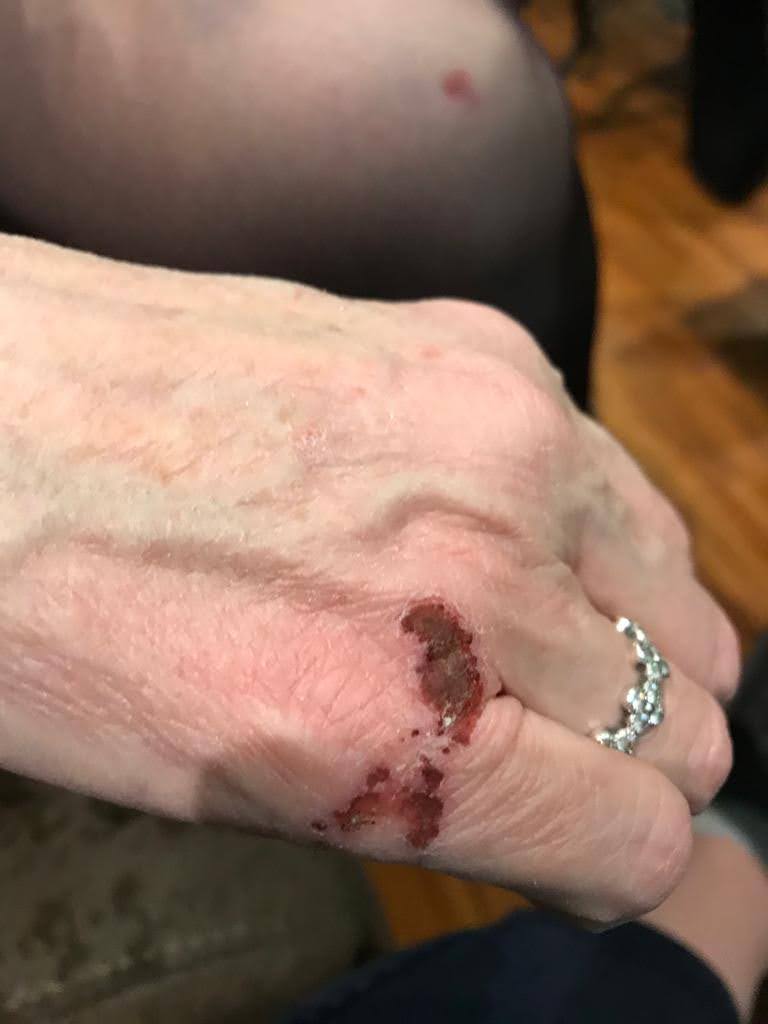
She was unable to get back up on her feet, as when she tried, the wind was so strong it kept her pinned down to the spot, making it impossible to get up. Three of the hotel staff came and helped her stand up and took her onto the bus. She was in total shock and felt sick, and wounds on her hands and knees were bleeding.
One of the fellow travellers alerted Hattice (the tour guide) to the fact that Diana had also been injured. Hattice then said she would take those who were injured to a pharmacy when they arrived in Split. Upon arrival, Hattice accompanied Diana to the local pharmacy, but the pharmacist refused to look at or treat the injuries because the wounds were open and bleeding. The pharmacy also didn't have any bandages, so Diana purchased some adhesive plasters and antiseptic spray and was directed to the café next door to wash her wounds.
They were both left to suffer and deal with their injuries on their own. Throughout that day, Diana’s hand and knees continued to bleed. Alicia had pins and needles in her arm from her shoulder to fingers, and her wrist was at a distorted angle as though it was dislocated. The swelling in her hand intensified, and she was unable to move it in any direction and could not bend any of her fingers. She also had bruising to her right hip, thigh, knee, forehead, and face.
When they arrived back at the hotel that evening, the damage from the storm was visible. Most of the trees surrounding the hotel had been blown over or uprooted. The crane that had blown over during the night epitomised the magnitude of the danger and severity of the damage.
Although Diana’s hand was still bleeding several days later, and everyone thought Alicia’s hand/wrist was broken, they weren't offered any medical assistance whatsoever. The tour guide/tour company didn't offer them any chance to go to a medical centre, to see a doctor, or to go to a hospital.
After arriving back in the UK, Diana attended the Accident and Emergency department at the local hospital. X-rays revealed torn ligaments in her right knee, and an infection and foreign bodies in her left hand. Antibiotics were administered, and the following day she underwent surgery to remove the grit and clean out the wound, and five stitches were applied to close it up again. Three months after the accident, a secondary infection occurred in her hand. She still has limited movement and use of her hand and may need a second operation in the future.
Alicia went to the emergency department, and the doctor was horrified that up until that point, she had not been seen by any doctor. The question was: “These are serious injuries, why didn’t the tour company do anything?”
She required a CT scan of her head, numerous x-rays, and an MRI. Alicia was suffering from concussion and multiple fractures and damage to her tendons, ligaments, ribs and nerves in her hand/wrist/arm. Due to the COVID-19 situation, she is still awaiting treatment to repair the damage. She will probably never get the full strength, motion, or function of her hand back again. Alicia still hasn't been able to get her hand fixed as there are several fractures and damage to the nerve.
RSD Travel did not provide any assistance during the trip and have denied any wrongdoing. They also refused to provide any compensation.
They believe that RSD Travel failed in their duty of care:
It was negligent to have the bus parked so far away from the door of the hotel. The fact that the hotel had arranged minibuses to take people from the door to the restaurant proved that the risk was known and foreseeable, and this accident could have been prevented. By having the bus parked so far from the door, it created an avoidable risk. This meant they had to walk past the hotel building to an area that was not shielded by the wind. If people had been kept in the reception area, and if the buses had been brought to the door for each group to safely get on their respective buses, this incident wouldn't have occurred. The weather was not something that RSD Travel could control, but the tour company could have controlled the situation by ensuring that the buses were brought to the door of the hotel. Failure to do this created a foreseeable hazard that allowed the accident to occur.
Besides, it was unsafe to stay at a hotel that was still under construction and located in the middle of a building site.
Lastly, it was negligent and a failure of RSD Travel’s duty of care to not provide medical assistance on either the day of the incident or on any of the subsequent days when the severity of the injuries was increasingly evident. Not providing medical assistance could reasonably be foreseen to cause harm, given that fractures and infections are more prone to complications if not treated immediately. A pharmacy does not and cannot provide the medical assistance required to assess and treat such injuries fully.
Follow our travel page for more.
Cultural Heritage of Istria and Southern Dalmatia Highlighted on French Arte TV
June 14, 2020 - European cultural TV channel Arte TV, in its 'Invitation to Travel' show, broadcast a series of reports on the rich cultural heritage of Istria and Southern Dalmatia.
HRTurizam writes that these reports were created as a result of the cooperation and engagement of the Representative Office of the Croatian Tourist Board in France.
"Such shows that reveal lesser-known cultural and historical facts of Croatian tourist destinations are our special challenge and imperative in the tourist promotion of Croatia on the French market, since cultural heritage is the main motive for 60 percent of French people to travel abroad," said Daniela Mihalic. Đurica, director of the CNTB Representative Office in France.
For the latest travel info, bookmark our main travel info article, which is updated daily.
Read the Croatian Travel Update in your language - now available in 24 languages
Join the Total Croatia Travel INFO Viber community.
The Istria portion of the show spoke to the owners of Istrian restaurants, but also winemakers, who testified to the precious eno-gastronomic value of Istria. They presented Rovinj, which they called a mini Venice, Pula, where the gladiator games were evoked, but also the interior of Istria, where the picturesque towns of Buje and Motovun are located. The report also mentions the most common traditional vessel in Rovinj, the batana.
The second report, entitled "French Kisses from Croatia", shows the rich influence of Napoleon in Southern Dalmatia, and through a conversation with historians, the "Adriatic pearls" of Dubrovnik, Split and Trogir were presented, which delighted Napoleon and his marshals, especially Marmont, so much that by their conquest they showed the world their superiority.
"This is another way to maintain a presence and visibility in our important markets and further interest the French, but also the Germans to revisit us as soon as possible," commented CNTB Director Kristjan Stanicic, announcing that the Arte TV team will film four new reports on Croatia in mid-August and early September.
But these are not the only stories about the Croatian coast, which were presented to French viewers. Earlier, a report on the island of Pag was published, in which the specifics of the famous bura wind were mentioned, as well as a report on Pazin with which the famous Jules Verne was enchanted.
Arte TV shows are broadcast six days a week and are watched by over 800,000 viewers a day. The recorded reports are repeated on several occasions and are also available in the Arte TV media library.
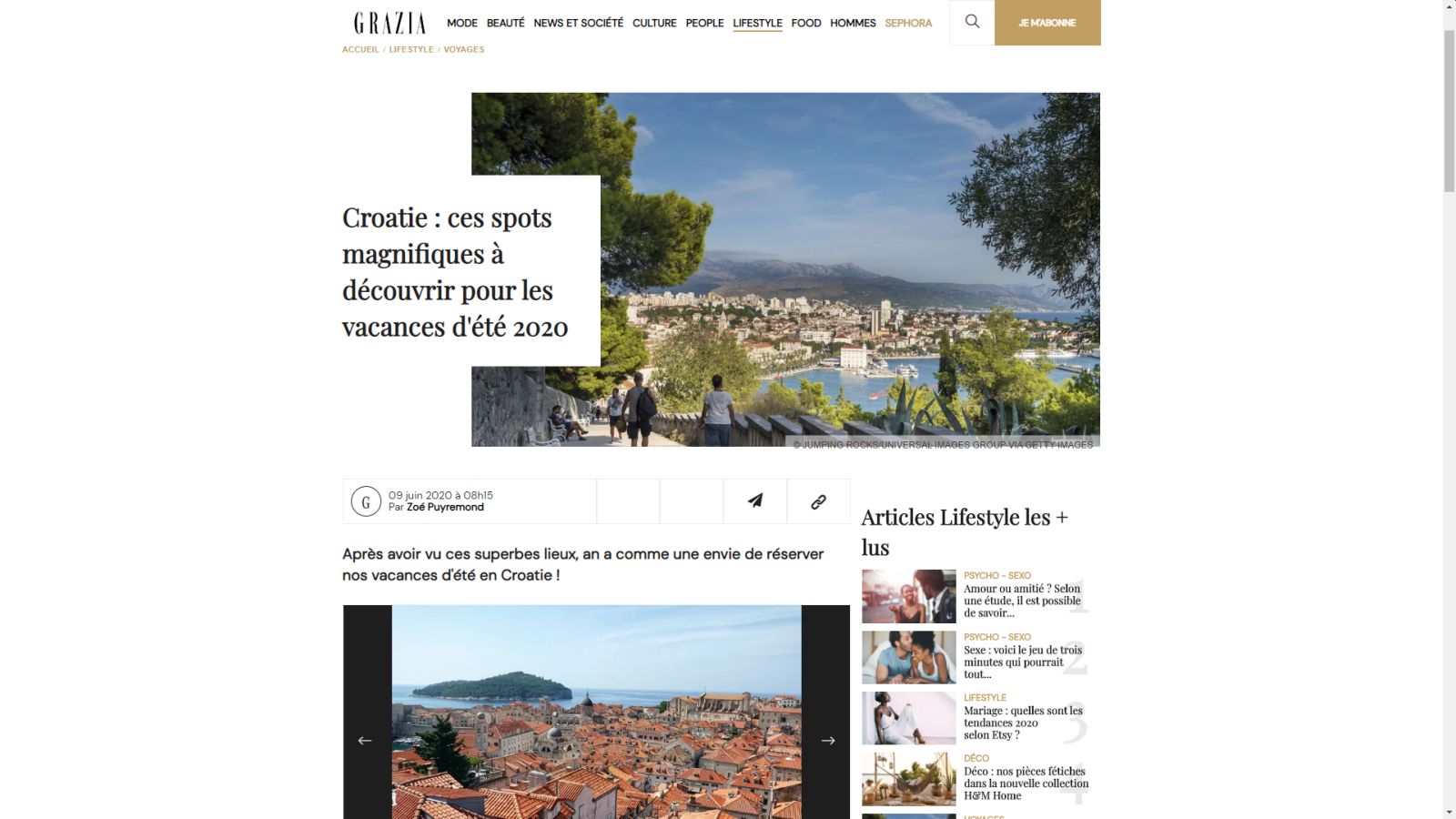
Finally, French lifestyle magazine Grazia also published the TOP 9 Croatian destinations that should definitely be visited this summer. On that scale were: Dubrovnik, Rovinj, Split, Zagreb, Plitvice National Park, Zadar, Hvar, Korcula and Krka National Park.


